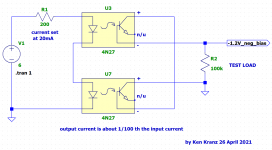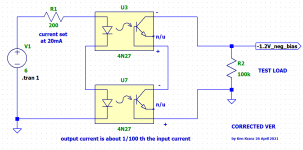There is often a time when a low current low voltage floating supply is required. I have used the following method most successfully on some of my solid state microcontroller projects.
It is a little known fact the base collector junction in a standard optocoupler works like a solar cell and produces an electric current. The junction works as a current source with a silicon diode shorting it out such that the voltage across it never exceeds about 600mV, from zero to 600mV it has a current transfer ratio of about 0.01 so 10mA into the LED will produce a current of about 0.01mA out, this action is quite linear and also quite fast unlike the action of a 4N27 operating in its normal transistor mode. I have used this topology to produce a reference voltage many hundreds of volts above and below ground. Some tube circuits the have a bias battery and can be modified using this style of floating supply. Care must be taken to ensure the drive to the LED is clean, hum in equals hum out, one could even filter at the output as the z is high and caps would be small.
As the supply output is fully floating it can be connected anywhere with any polarity.
The 4N27 LED's have a forward voltage drop of about 1.2V so most of the time a few of the input LED's can be connected in series.
Ken K
It is a little known fact the base collector junction in a standard optocoupler works like a solar cell and produces an electric current. The junction works as a current source with a silicon diode shorting it out such that the voltage across it never exceeds about 600mV, from zero to 600mV it has a current transfer ratio of about 0.01 so 10mA into the LED will produce a current of about 0.01mA out, this action is quite linear and also quite fast unlike the action of a 4N27 operating in its normal transistor mode. I have used this topology to produce a reference voltage many hundreds of volts above and below ground. Some tube circuits the have a bias battery and can be modified using this style of floating supply. Care must be taken to ensure the drive to the LED is clean, hum in equals hum out, one could even filter at the output as the z is high and caps would be small.
As the supply output is fully floating it can be connected anywhere with any polarity.
The 4N27 LED's have a forward voltage drop of about 1.2V so most of the time a few of the input LED's can be connected in series.
Ken K
Attachments
Pure DC input and pure DC output, think light from a LED shining on a solar panel (the collector base PN junction), it works like solar panels on your roof 600mV out.
There are Photovoltaic Mosfet driver chips that can produce up to 7 or 8V per unit, and some are dual units. These have a series string of PV diodes inside plus an LED driver.
Some part #s
International Rectifier PV15050N, PV15080N
Texas Instruments TLP1918
Avago ASSR-V621, ASSR-V622
Youtube video on PV drivers:
Using Photovoltaic MOSFET Drivers - YouTube
Some part #s
International Rectifier PV15050N, PV15080N
Texas Instruments TLP1918
Avago ASSR-V621, ASSR-V622
Youtube video on PV drivers:
Using Photovoltaic MOSFET Drivers - YouTube
smoking-amp You are correct, I have used those chips, the 4N27 style is cheap readily available and suits many applications where only a small voltage is required. Many people don't know about this mode of operation.
- Home
- Amplifiers
- Tubes / Valves
- Floating bias supply.

